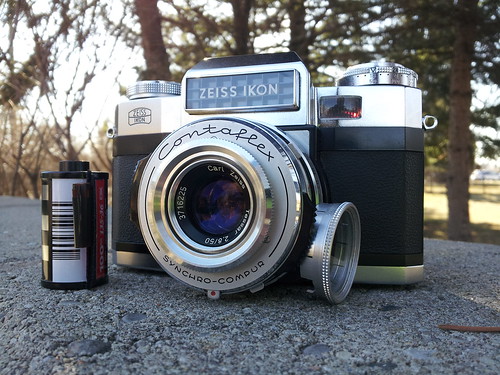When I got this camera, it had a minor fault. It was inoperative. The shutter was jammed, and the mirror was in its upward locked position. That, sadly, meant that this camera was not going to be able to be used until I sent it out for service. Unfortunately, I also did not have the money to get it CLAd. So onto the repair forums I started searching. That search led me to a thread regarding the self-timer and the camera completely locked up. I learned that the self-timer on this camera wasn't the most robust, and was prone to failure. So after I tried to remove the lever to see if I could manually release the timer that way (which caused it to slip instead) I popped open the bottom of the camera.
That's where I saw the Self-Timer gears. Using a fine flat screwdriver, I began to advance the gears, which much to my surprise, released the shutter.
And from that point on, this camera has been in service!
Now one of the first things I did after I got it back to the functional world, was clean it. It was very grimy and dirty! I mean, not 'dirty' by the sense that it went through a dirt bath, but it had definitely seen some use and some dirty hands. So I did the usual cotton swab (Q-Tips) and a alcohol to clean it. This way it disinfects and also penetrates the stuck on dirt for easy cleaning.
Besides, it's not like you can submerge the thing under any kind of solution to clean it.. Then again, Iso 99% probably wouldn't hurt it, considering that it's not conductive, and evaporates rather quickly. AND you can submerge a computer board under Iso 99% and it won't short it out.. Even under power! But that is definitely something I refuse to try. Any particulates on that board will contaminate the solution, and could cause it to become conductive and short it out..
No thanks!
Of course, now looking at the camera in these photos, you'd wonder... Wait, that was the first thing you did was just clean it? Then when the heck did the leatherette fall off and it get the denim look?
Well... that was not that long ago (unless you're reading this 10 years in the future from writing it).
I decided that I was tired of the 'black' look it had, and wanted a change. Well, I popped into my local Wally-Mart (Walmart) and found these denim patches. They are "Iron" On, but I'm not about to iron a camera! The Pentaprism is supposed to be humpy bumpy!
So I used a little bit of adhesive (the same stuff that you will see me referring to in the Argus C3 repair). It does a great job holding on leatherette, and even Denim patches to the camera.
Barely bleeds through too! In fact, if it does, once it dries it just peels right off. Really cool, and easy clean up!
So... Nikon, huh? Yeah, I know, I've got more Canon cameras than your local photo store, but that's because it's a great system. I haven't been much of a Nikon guy.... Ever! That said, however, they do make some nice looking cameras.
You may see me joking about how Canon made no sense when they started making these Canon Nikon cameras. I know they are different companies, and in fact, Nikon is older. Considering that at the beginning of the Canon brand, Nikon was making their lenses for them. But, that changed later when Canon decided to branch away from Nikon entirely, and start making their own lenses. And to be perfectly honest, it's a good thing they did. Canon glass is a bit better! I'm not saying a lot better, but a bit. Of course, if I truly want to get myself in hot water with a lot of Canon and Nikon Aficionados... Konica had the best glass! Yes they did. Now I'm not comparing the Zeiss optics or even Leitz optics. Leitz had a very soft contrast to their lenses, which actually worked very well. I'm not talking about a soft image, not in the slightest. Their lenses are very sharp, but the contrast is very soft in comparison to a Zeiss lens. This is what gives Leica their legendary look. Where as Zeiss is considered to be some of the sharpest and best glass, it is also contrasty in comparison to Leitz glass.
That's not a bad thing! Out of Focus transitions on Leitz and Zeiss is amazingly smooth. When was the last time you looked at a shot on a Rolleiflex or Hasselblad and said, "Man, that bokeh is nasty!" I'm referring to the 'big' 5 camera makers. Nikon, Canon, Pentax, Konica (Minolta) and Olympus. Konica has some phenomenal glass! It is just too bad their cameras were shyte in comparison! I have a Auto S2 rangefinder that completely locked up and jammed for no reason. I was loading it, and when I went to load in the film, the winder jammed and it has not worked since.
POS!
Of course, this isn't a "LETS BASH KONICA" post, since it is about a Nikon camera that.. well, has a weird name! The Nikkormat. I don't really know the history with the name, but hopefully someone will inform us all in the comments below.
Also, a lot of people believe that this camera can only be used with a Pre-AI lens. You know, the ones with the Forks on it? Yeah, Auto Indexing.. Well they're wrong! It can take all the lenses that you can mount on a Nikon and use them. Err, I wouldn't mount a Crop sensor lens on it though. Unless you like small image circles, and no aperture control. But aside from that, I can use my Nikon lenses (I have 3) on this camera without any issues at all. I mount, then adjust the "Fork" pin on it, start the meter, and push the little button to give me "stop down" metering. Works every time!
So lets start with an actual review on this camera.
Looking at the top, in the photo above, you will see the (Starting on the left) film rewind, exposure meter (External), pentaprism hump with X-Sync flash hot-shoe, Stop-Down button, film plane indicator, Film Frame counter, shutter release, and finally the winder arm.
The X-Sync PCPort right below and beside the rewind takes all standard PC-Port plugs.
The rewind knob is just like all others, flip out crank, and an arrow to tell you to rewind in this direction to prevent the film from jamming up while rewinding.
Now raise your hand if you've rewound the film the wrong way...
Come on. Don't be shy.
Wow.. that's a lot of people! Come on, can't you read an arrow?
Then there's the exposure window. Don't worry, you don't have to look at this window. Ever! It is fine if you're using a RF (Retrofocus) lens and metering through the lens with the mirror up and out of the way, since that is the only way you can use a RF lens.
With the mirror up and out of the way, the viewfinder is BLACK so you would have to use the external window for metering. But I would more recommend a hand-held or sunny ƒ/16 type metering instead, as I just don't see how using a tiny window for metering is of any use when compared to using a much easier to read needle on a hand-held meter.
Speaking of the meter, it actually has a pretty nifty way to activate it.
No funny switches, buttons or levers in odd places on the camera, but the one right beside your thumb. Yup! The advance lever!
Simple flip it out of the 'rest' position, and the meter turns on! It's that simple!
Just remember that when you are done metering, or leaving the camera for an extended period of time, tuck the lever back, or anticipate a dead battery pretty soon!
Looking beyond the advance lever, the shutter release. I have one of those interesting "Soft-Release" shutter buttons in mine, just for a softer touch.
I do find they make a difference! The tiny release (normally) is not so difficult to use, but the soft-release makes it far easier to find when you're not looking at the camera but through it, and much easier to press.
Especially if you have fat fingers, which I sometimes feel that I do. I may not really have fat fingers, but I'm sure there are times where everyone feels they do.
Oh.. You don't? .. Oh you're just getting back at me for the arrow comment. I see.. Oh.. you are not getting back at me about the arrow comment, you just don't have fat fingers. How nice.. Good, well they must not hurt you when you're picking your nose!
Next the "Depth of Field" button. Since I am using AI and AI-S lenses on my Nikkormat, I don't really have much choice but to use Stop-Down metering.
The advantage to Stop Down metering is that you also get a "Depth of Field" preview, so that you can see what is going to and not going to be in focus when you throw the shutter release.
Also, the image you see is pretty much what you get. You'll get to see how the bokeh will look, and whether the pinpoints of light in the trees behind are helping, or hindering, the image.
A little bit of work, and perhaps recomposing, and they should help. Just remember, make sure there are no weird appendages growing out of your models head! You don't want them to have a tree branch sticking out of their ears when you trip the shutter. If you're working TFP and you give them one of those, they'll either find it mildly amusing, or you might end up shunned by them for later work, if you just happened to get along well.
Also, the shutter speed indicator dot is located at the front of the camera. I don't use that dot to know what the shutter speed selected is, as you can clearly see it in the viewfinder, but again, if you're using a RF lens, you cannot see the viewfinder, as it will be quite dark! So make use of this dot, it might help save your photo! Not to mention, you scroll back up a bit, you'll notice that the speeds above 1/125s are red. Why is that?
Well, that's simple. See, at every speed below 1/125 (including 1/125) the shutter is fully synced up with the flash. But when you start shooting at 1/250s and above, the shutter is no longer synced to the flash, and you will get banding across your image. So if you're using flashes or strobes, stick to 1/125s or slower.
The mirror lockup and indexing fork are the next stop on the tour. The mirror lockup switch (located just above the Lens release button) will flip the mirror up and out of the way, which is good for LONG exposures to prevent mirror slap and camera shake, or to use those RF lenses I keep mentioning. Since those RF lenses usually use a lens element that actually protrudes into the camera body, if you don't flip the mirror up before mounting it, you can't actually trip the shutter. The mirror will crash into the back of the lens, possibly damaging it, and even possibly breaking the mirror!
Best case scenario, it just jams the shutter until you remove the lens and it can complete its travel.
Worse case scenario, a broken mirror and a big ding in the rear element of the lens.
Make sure you flip the mirror up and out of the way when using those lenses!
At the bottom of the camera now, this is where we find basic information on it. The "Made in Japan" stamp, the battery door, tripod socket, and the film-speed indicator. I know most times it is located at the top of the camera somewhere, instead of here but this is where it is on this camera.
I know, they are just weird! Heaven forbid you bite your names (Get your fingers out of your mouth!) you won't be able to adjust the film speed.
At the end of the shutter speed dial lever there is a tab. Pulling out this tab will unlock the film speed indicator nub. While pulling the tab out, you can then slide the film speed indicator nub to the proper film speed of the film loaded. See what I mean about biting your nails? It's a terrible habit! Yes yes... Nervousness, and boredom. I get it, but you know how much bacteria can be found under your nails? Yuck!
And finally, the front of the camera. Lens mounted, self-timer switch in the "UPWARD" position (except mine is broken).
So why Nikon? You've been a staunch Canon supporter for years, and you now own a Nikon as well?
Actually, I've owned this Nikon for a few years now, and have put it through its paces from time to time. It is a very solid little camera, heavy too, and can take a beating. When they talk about a camera being built like a tank, this one is one of those cameras. It is, quite literally, built like a bloody tank! It's solid, heavy, metal, and well designed (save for the self-timer).
I have enjoyed using it, and will continue to enjoy it. Of course, now that I have recently (see not reading this 10 years in the future or more and thinking.. Recently?) got a Nikon F90 camera (autofocus) this Nikkormat might spend a bit more time on the shelf at times. But when I want simplicity, and a solidly built camera that might hurt if you drop it on your toe, I'll reach out to my shelf, and grab my Canon FTb or Praktica L2! (Yeah take that Nikon owners, bwahaha!)
No, I will continue to use this camera. It is a lot of fun to shoot with, and you do get the "Journalist" type look when you are carrying it around. Unless I happen to have my big bright Neoprene "NIKON" neck strap on. Then I know I fit in with the Nikon crowd.
Loud.. Obnoxious, and gaudy!
So... How about some sample images from this camera, right? Alright I can give you some of those..
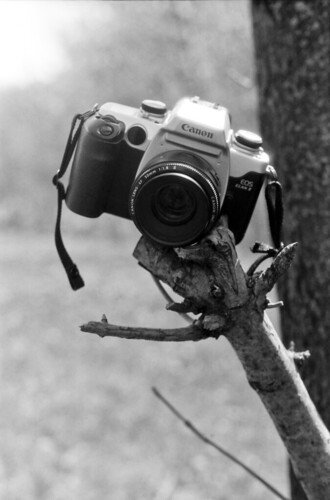 |
| "Canon EOS ELAN II" Nikkormat FT/2 - Nikon 50mmƒ/1.8 Polypan F film |
 |
| "Wish it Was Beer" Nikkormat FT/2 - Fuji Superia 800 - Nikkor 50mm ƒ/1.8 |
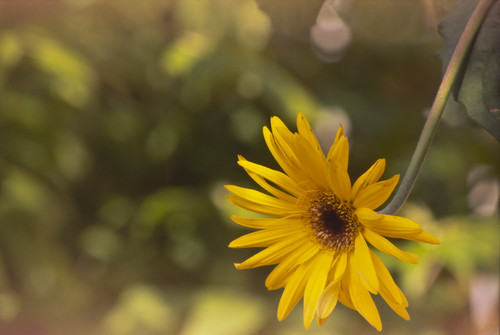 |
| "Sunnyside Up" Nikkormat FT/2 - Sigma 75-200mm ƒ/3.5-5.6 - Fuji Velvia 50 |
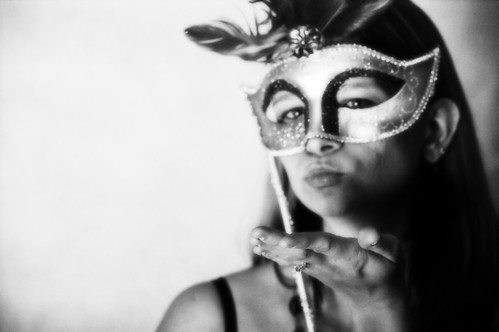 |
| "Kiss and Tell" - Nikkormat FT/2 - Sigma 75-200mm ƒ/3.5-5.5 - Polypan F Film |
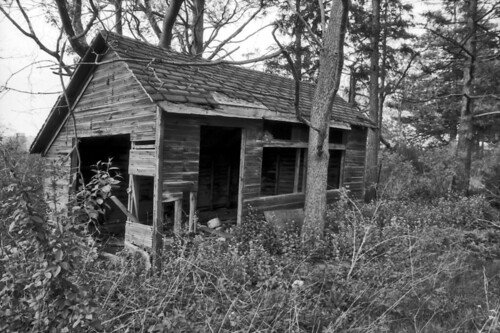 |
| "Rundown" - Nikkormat FT/2 - Tokina 28mm ƒ/2.8 - Polypan F Film |
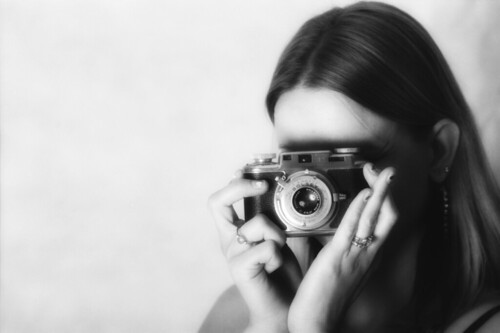 |
| "Click" - Nikkormat FT/2 - Sigma 75-200mm ƒ/3.5-5.6 - Polypan F Film |
Tech Specs;
Nikon Nikkormat FT/2 35mm Single-Lens Reflex camera
Nikon Nikkormat FT/2 35mm Single-Lens Reflex camera
Frame Size: 24mm x 36mm Full Frame captured on 135 film
Mechanical Release Vertical Travel Metal shutter curtain
Single Button Cell PX675 Silver-Oxide 1.5v battery (Original Nikkormat FT uses older 1.3v Mercury Cell) For the meter
CdS cell TTL Meter using a "Match the Needle" type metering system
Nikon Pre-AI Bayonette Mount
Shutter speeds of 1s through to 1/1000s + Bulb w/X-Sync at 1/125s
Weight... Heavy! Don't expect to be able to hand-hold this camera all day without some hand cramping later. Also, make sure you have a comfortable neck strap, or you might find that you're neck gets sore too.
Until next time, keep those shutters firing!
Stay tuned as we take an in-depth look at....
The Contaflex Super-B....!
Stay tuned as we take an in-depth look at....
The Contaflex Super-B....!
